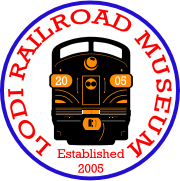Lodi Depot
The Early Days
The Lodi Depot's lineage can be traced to its original construction along the Wheeling & Lake Erie Railway (W&LE) in early 1882. The wooden framed depot is of modest design with horizontal siding and a hip roof with slate roof tiles. According to the original blueprints, the depot originally stood closer to Railroad and Harris Streets. A passing siding ran between the depot and Railroad Street. The depot had a waiting room for passengers, restrooms and a ticket office in the west end and an agent's office and mail room in the east end.
 Beginning in 1904, the Baltimore & Ohio Railroad (B&O) relocated
their main line closer to the village of Lodi and W&LE's station. At
this time, W&LE increased the length of the depot to add more freight
and mail space, increasing their income from LCL freight, mail and the
Railway Express Agency.
Beginning in 1904, the Baltimore & Ohio Railroad (B&O) relocated
their main line closer to the village of Lodi and W&LE's station. At
this time, W&LE increased the length of the depot to add more freight
and mail space, increasing their income from LCL freight, mail and the
Railway Express Agency.
There is no confirmed date on when the depot was moved to its current location. Harris Street was vacated south of Railroad Street and the depot was moved a short distance southwest of its original location. Another addition to the depot was added in 1909 as well as a large coal bunker and small warehouse.
World War I and Bust
During World War I, the Federal Railroad Administration (FRA) took over the nation's railroads. Although the railroads ran more efficiently under the FRA's supervision, by the war's end, the railroads were worn out from deferred maintenance. After the release of the railroads by the FRA, many railroads, including the W&LE were forced into receivership in order to refinance and rebuild their physical plant.
In 1920, the W&LE started rehabilitating their tracks and buildings. The depot was repaired and all buildings on the property were repainted to gray with green trim as these colors were the least expensive. In later years, the trim color changed but the depot was thereafter gray.
After the war, railroads enjoyed a modest but short-lived boom, then economic recessions and layoffs affected the country. By 1926, another boom period took America by storm. Speculation was high and the stock market soared. Detroit was turning out thousands and thousands of cars and trucks a year. Then the great depression hit when Wall Street crashed in 1929.
World War II
All passenger service on the W&LE was discontinued on July 17, 1938 as such service was not profitable. However, the W&LE continued to use the depot for mail and LCL freight service. But by the end of World War II, the B&O had the mail and freight contract for Lodi. The W&LE still kept a station agent at the depot to monitor train movements between Bellevue and Brewster, Ohio. The depot became a Maintenance of Way (MOW) headquarters and storage facility.
Change
On December 1, 1949, the W&LE was leased to the New York, Chicago & St. Louis Railroad, known familiarly as "The Nickel Plate Road" (NKP) for 99 years. Operations at the depot continued as before as the maintenance hub between Bellevue and Brewster. On October 16, 1964, the NKP was merged into the Norfolk & Western Railway (N&W). Through the N&W years, the activity at the depot remained unchanged.
 On January 31, 1977, the depot was nearly destroyed when an eastbound
freight collided with
a loaded propane truck at the Wean Street crossing sending the trailer
barreling into the
west end of the depot. The trailer destroyed the restrooms and waiting
room. As the dust was
settling, the propane was leaking and the depot stove was burning. An
astute propane company
employee closed the leaking valve and prevented a larger catastrophe.
The N&W still needed
the use of the depot so they removed the damaged portion and enclosed
the opening with a new
wall.
On January 31, 1977, the depot was nearly destroyed when an eastbound
freight collided with
a loaded propane truck at the Wean Street crossing sending the trailer
barreling into the
west end of the depot. The trailer destroyed the restrooms and waiting
room. As the dust was
settling, the propane was leaking and the depot stove was burning. An
astute propane company
employee closed the leaking valve and prevented a larger catastrophe.
The N&W still needed
the use of the depot so they removed the damaged portion and enclosed
the opening with a new
wall.
In 1982, N&W merged with the Southern Railway and formed the Norfolk Southern Railway (NS). NS discontinued the station agent's job in 1988. Thus, after 106 years, the depot was unmanned. NS continued to use the depot as an MOW facility. Also in 1988, NS petitioned the Interstate Commerce Commission to void the lease and take over the W&LE outright. On September 1, 1989, permission was granted.
The old W&LE was gone, but in May 1990, NS sold of a large amount of track that was the old W&LE, including the line through Lodi, along with some other lines to a new company. This new railroad company was named the Wheeling & Lake Erie Railway!
Rebirth
 The Lodi Railroad Museum was formed as a non-profit corporation to
save the depot. The W&LE
donated the depot to the Lodi Railroad Museum in 2008.
The Lodi Railroad Museum was formed as a non-profit corporation to
save the depot. The W&LE
donated the depot to the Lodi Railroad Museum in 2008.



